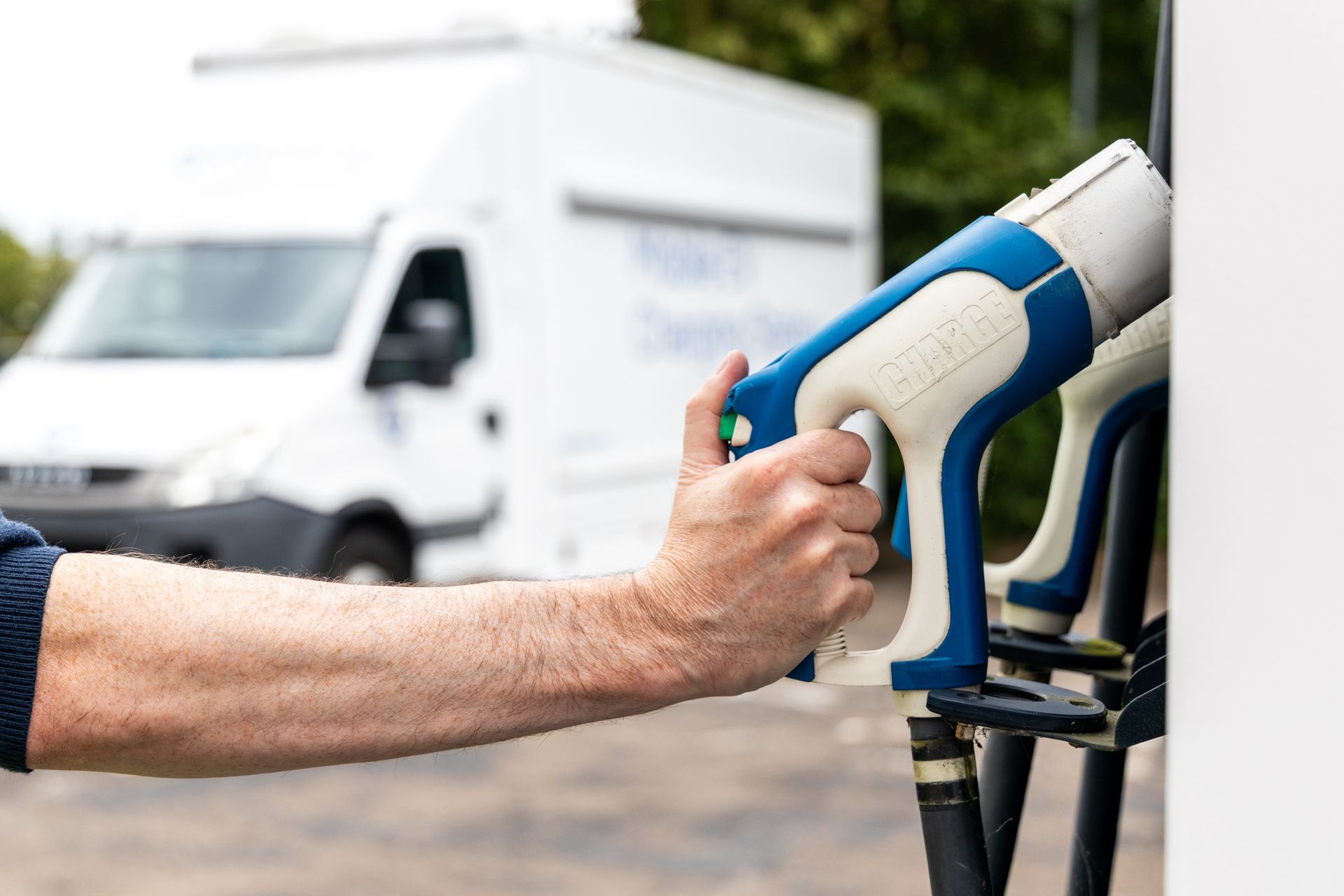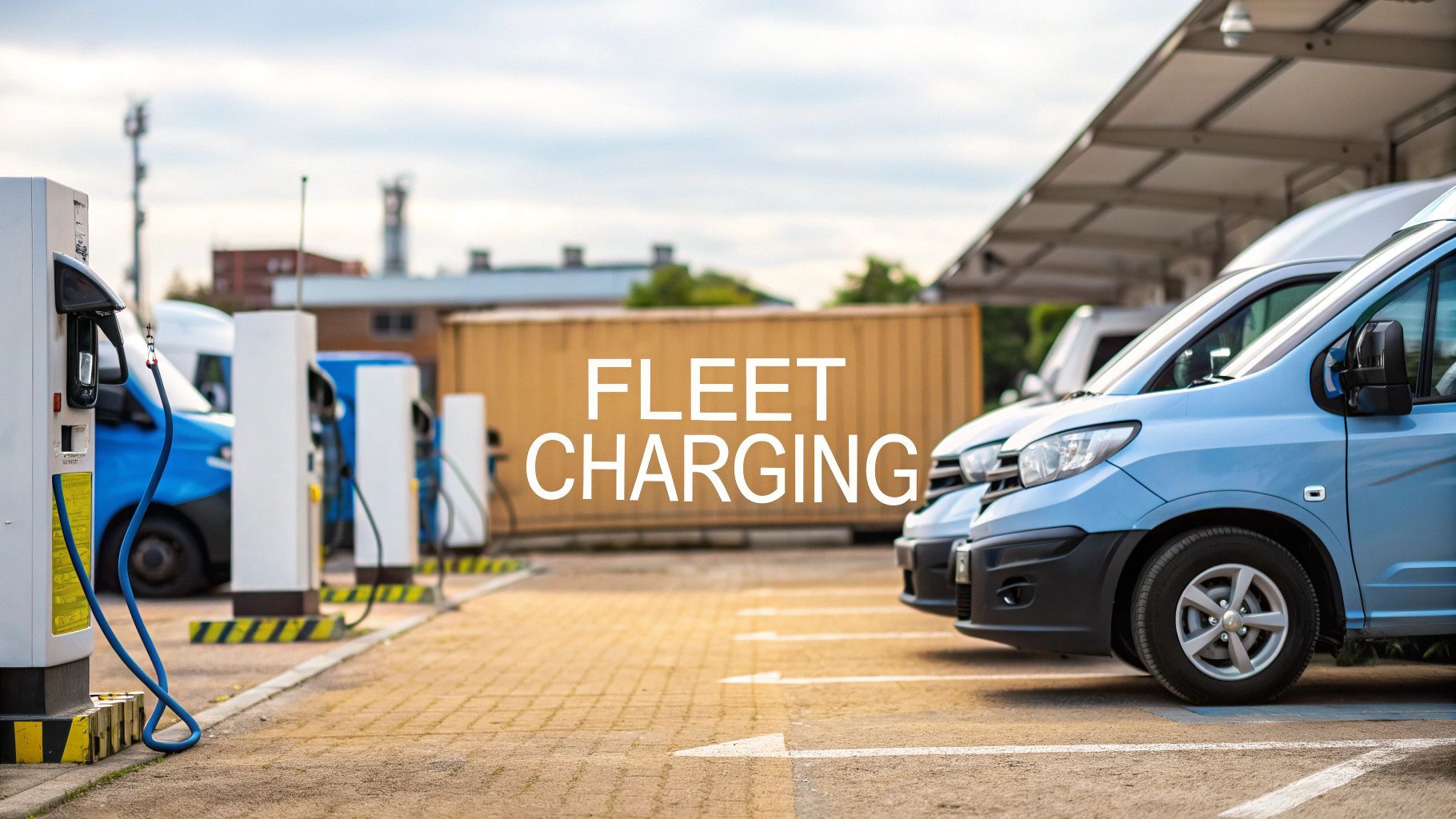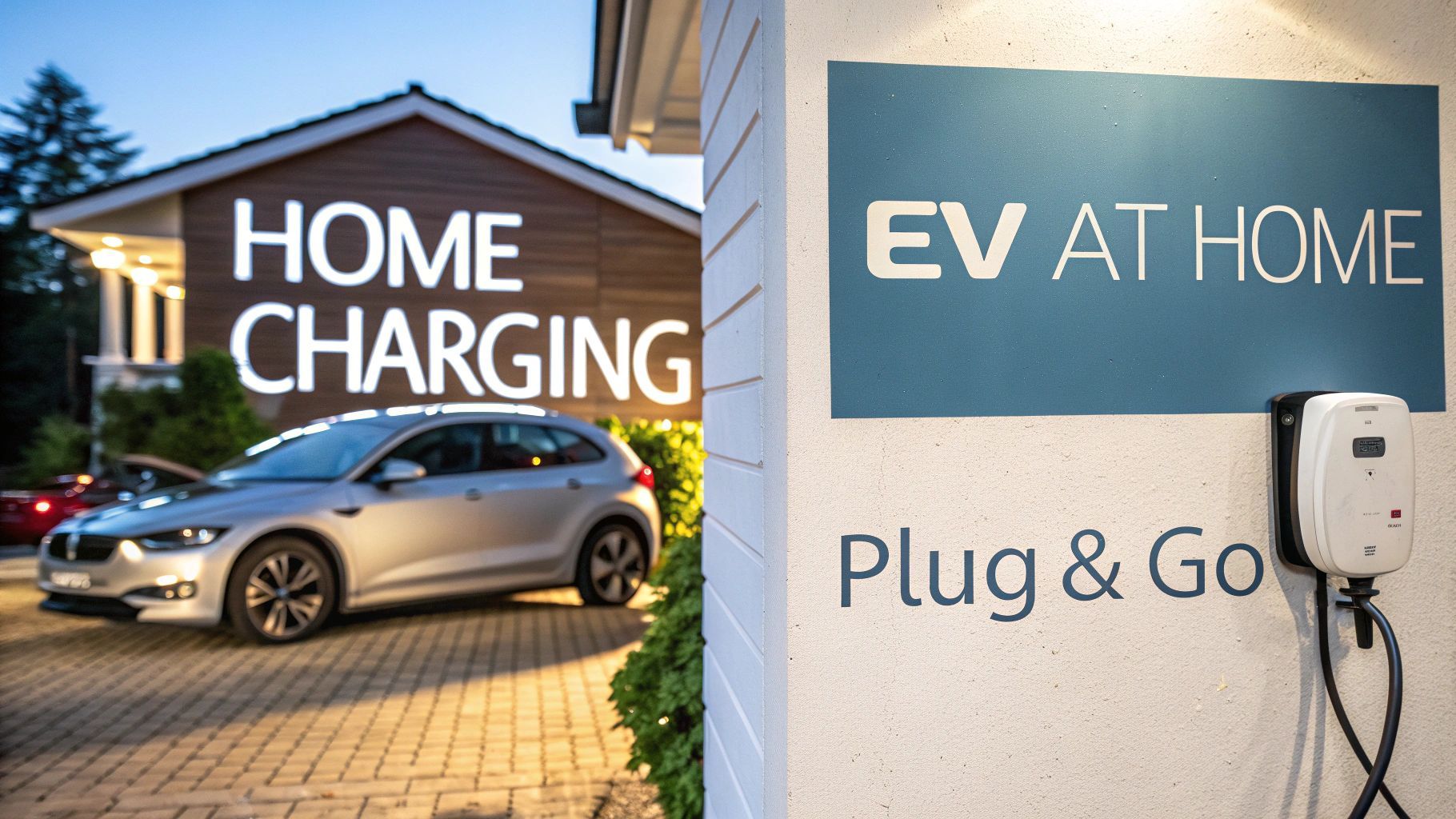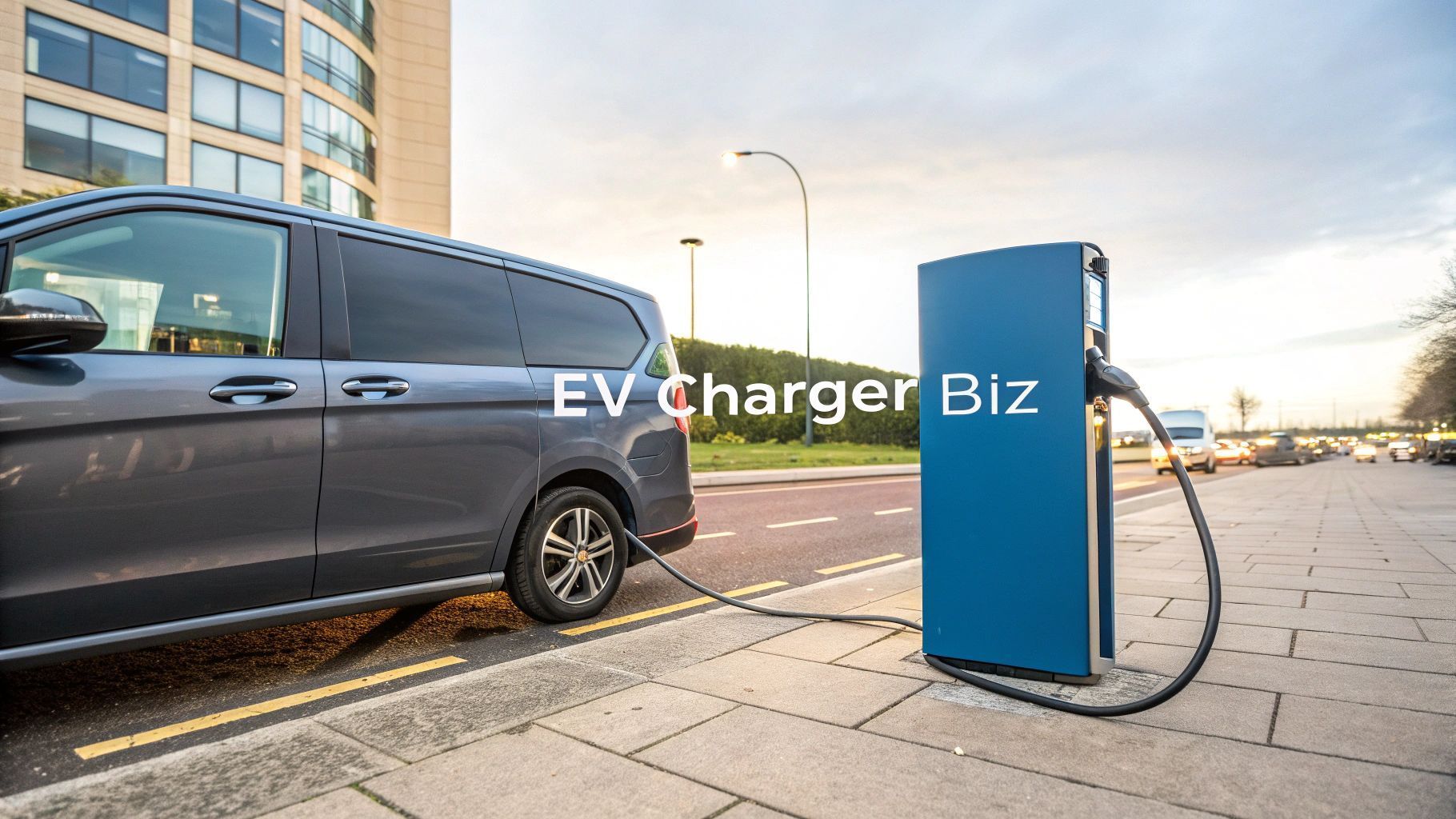Curing Electric Vehicle Range Anxiety for UK Drivers
We’ve all felt that little jolt of panic when our phone battery dips into the red. That sudden realisation that you're about to be cut off, stranded without a connection. That, in a nutshell, is electric vehicle range anxiety: the fear that your car will run out of juice before you can find a charging point.
It’s a powerful feeling and for many UK drivers thinking about making the switch to electric, it's the biggest psychological hurdle to overcome.
Demystifying The Fear of a Flat Battery
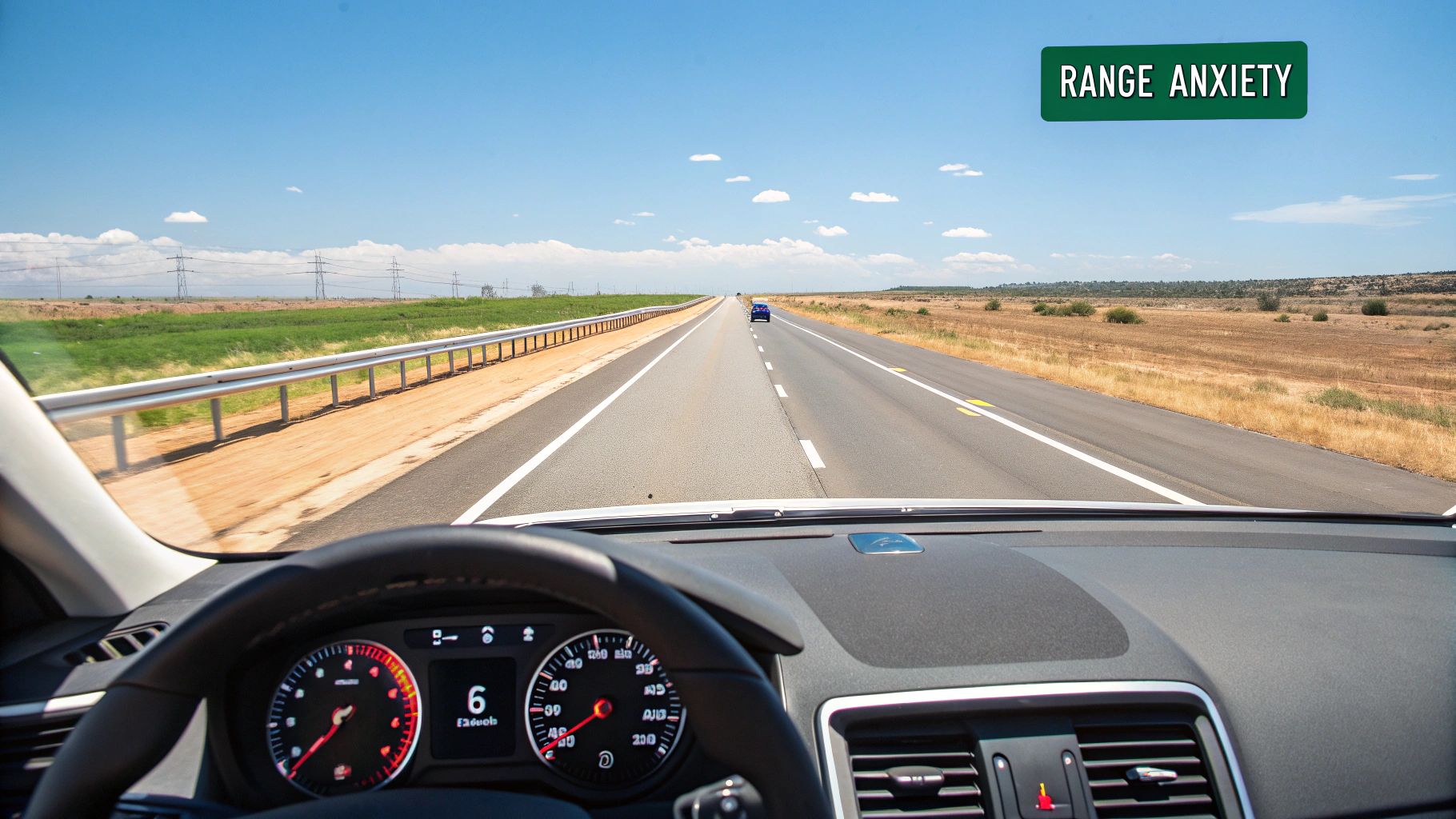
This worry about running out of charge is a hangover from the early days of EVs, when batteries were smaller and public chargers were genuinely few and far between. But times have changed. Drastically.
Today’s electric cars boast seriously impressive ranges and the UK’s charging network is growing at an incredible pace. At its heart, range anxiety isn't really about the car’s technical limits anymore; it's about a driver's confidence in the whole electric ecosystem.
Perception vs Reality
The truth is, the fear of getting stranded is now far more about perception than reality. While it’s a valid concern for anyone yet to own an EV, it’s a feeling that tends to fade very quickly once you actually start driving one.
Most owners get into a simple rhythm of charging at home overnight, much like a smartphone. With that and the sheer number of public stations available, most drivers almost never find themselves in a low-battery situation.
A survey from late 2023 highlighted this gap perfectly. It showed that while range anxiety is a top concern for over half of prospective buyers, a separate study of current EV drivers found that more than 75% of them rarely or never experience it. It just goes to show, the fear is strongest before you get behind the wheel.
The core issue isn't whether an EV can make the journey but whether the driver believes it can. Overcoming this psychological barrier is the key to widespread EV adoption.
Understanding the Terminology
Getting comfortable with the world of EVs also means getting to grips with the language. Terms like kWh , AC/DC charging , and regenerative braking might sound a bit technical at first but they’re simple concepts that put you in control.
To get up to speed quickly, our complete EV charging glossary offers clear, straightforward definitions. As you’ll see, modern tech and innovative services have all but made range anxiety a thing of the past.
The Reality of Driving an EV in the UK
It’s time to cut through the noise and look at the real-world facts of EV ownership. The truth is, modern electric cars are more than ready for the average UK driver and the charging infrastructure is already here to back them up. Today’s EVs offer a driving range that easily handles our typical daily needs.
On top of that, the UK's public charging network has grown at an incredible pace. By grounding this conversation in actual data, we can swap outdated fears for current facts and show that driving an electric car in the UK isn't just possible—it's practical.
The Psychological Gap
A recent UK study revealed something fascinating: electric vehicle range anxiety is largely a psychological hurdle, not a practical one. Think about it. The average electric car can now travel well over 200 miles on a single charge yet the typical UK car journey is just 10 miles .
This disconnect shows that the fear of running out of power is often more of a mental block than a reflection of reality. It's a bit like the panic we feel when our phone battery drops below 10%, even when we're right next to a charger.
The chart below really brings this to life, showing the gap between driver concerns and the actual state of the UK's charging infrastructure.
As you can see, there’s a clear mismatch between perception and the extensive support network already in place across the country.
A Network That Outnumbers Petrol Stations
One of the most powerful stats to put electric vehicle range anxiety to bed is the sheer scale of the UK's charging network. The country now has over 40,000 public charging points , a figure that has officially surpassed the number of petrol stations. This is boosted by an estimated 400,000 additional chargers installed at homes and workplaces.
What this means is a dense, accessible network where you’re rarely far from a place to top up. This extensive infrastructure acts as a safety net that, in reality, you'll likely seldom need.
Think of the charging network like cash machines. They are everywhere and it’s reassuring to know they exist but you probably won’t need to use one every single day. Most of your charging will happen conveniently overnight at home.
Of course, getting to grips with the different types of chargers and networks is key to feeling confident. To learn more, check out our guide on understanding the UK's public EV charging point networks in 2025.
Putting Daily Driving into Perspective
To really see why range anxiety is becoming a thing of the past for UK drivers, it helps to put the numbers side-by-side.
Modern EV Range vs Average UK Journey
This table compares the capabilities of a modern EV with typical UK driving habits, showing just how well-equipped they are for our daily lives.
| Metric | Distance (Miles) | Implication for EV Owners |
|---|---|---|
| Average Daily Commute | ~20 miles | An EV with a 200+ mile range can handle over a week of commuting on a single charge. |
| Average Weekly Mileage | ~140 miles | Most modern EVs can easily cover an entire week's driving without needing a public top-up. |
| London to Manchester | ~210 miles | A common long-distance journey is achievable on a single charge for many new EV models. |
The data doesn't lie. For the vast majority of journeys, a modern EV has more than enough battery to get you there and back with plenty to spare. The idea of running out of power during a trip to the shops or the office simply doesn’t match the facts.
While it's always wise to be prepared, it also helps to know that professional support, like a responsive towing answering service , is available for any unforeseen roadside issues, adding that extra layer of reassurance for any driver.
Simple Habits to Make Range Anxiety History
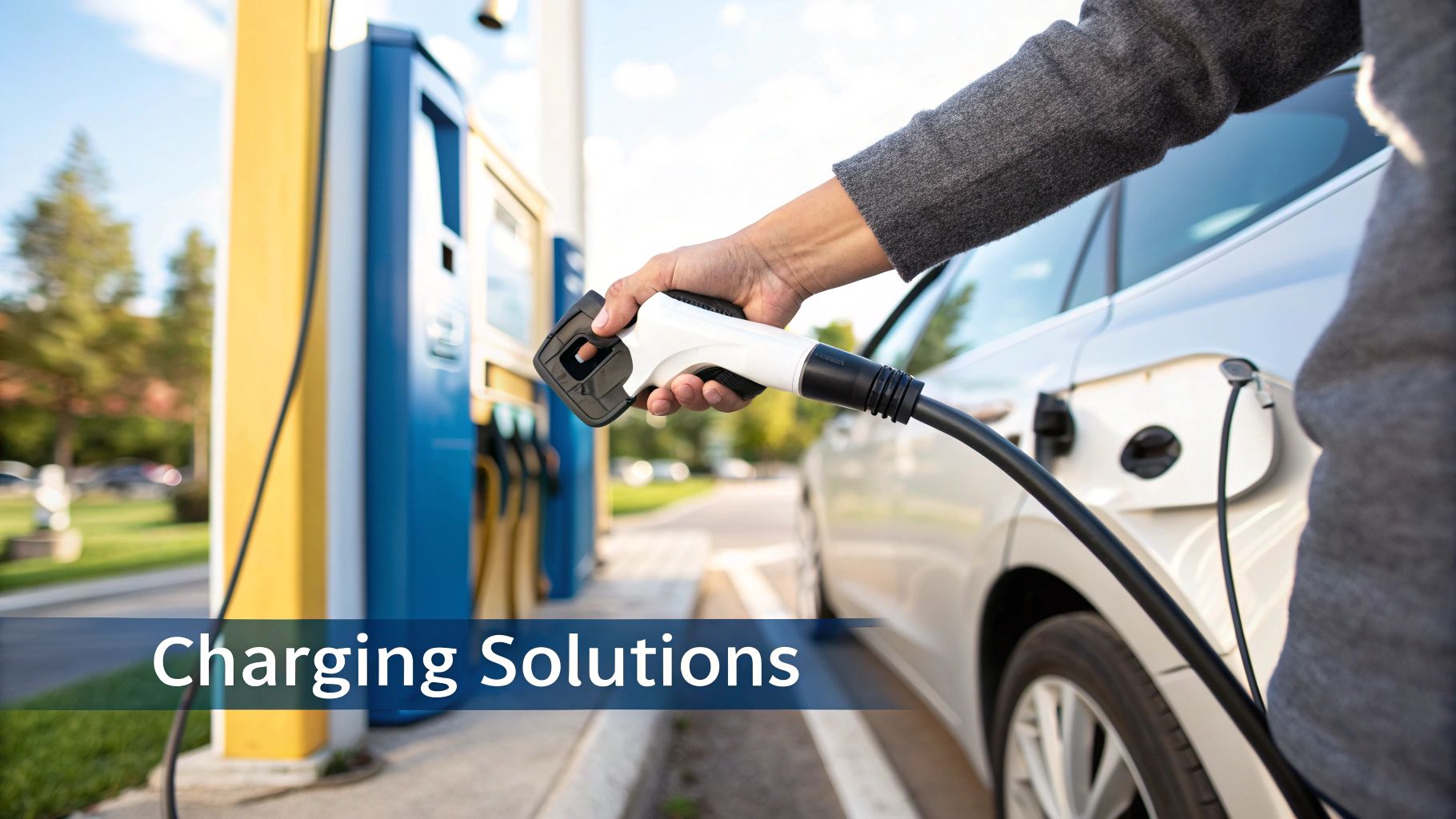
The secret to a stress-free electric vehicle experience isn’t buried in complicated tech. It’s all about building a few simple, effective habits. By adopting some straightforward routines, you can take back control and make electric vehicle range anxiety a distant memory. It’s about turning charging from a nagging thought into a seamless part of your daily life.
The most powerful habit is also the easiest: treat your EV like your smartphone. The vast majority of owners simply plug their car in overnight at home. That one small action means you wake up every single morning with a full battery, ready for whatever the day throws at you—from the usual commute to unexpected errands.
This simple overnight routine completely changes your mindset. Instead of worrying about where to find a charger during the day, you leave the house with a ‘full tank’ every time. It’s a consistent approach that removes the main cause of range anxiety for daily driving and turns your home into your own personal fuelling station.
Plan Your Long Journeys with Confidence
For those longer trips that go beyond your car’s single charge, modern apps are an absolute game-changer. These trip-planning tools automatically map out your route and build in the necessary charging stops. They transform a potentially stressful long drive into a well-organised journey with convenient, planned breaks.
These apps are clever, too. They take into account your car's specific model, its current charge and even the terrain to plot the most efficient route. You get a clear plan showing exactly where to stop, for how long and what kind of charger you’ll find there. This proactive planning takes all the guesswork out of the equation, ensuring you pull into each charging point with plenty of power to spare.
Master Your Vehicle’s True Range
Getting a feel for your car’s real-world range is another crucial step. The advertised range is a great starting point but real-world factors like weather and your driving style will always have an impact. Learning how your vehicle performs in different conditions is empowering, giving you the confidence to judge distances with far greater accuracy.
- Cold Weather: In winter, battery efficiency can take a hit and blasting the cabin heater uses a surprising amount of energy. A great tip is to pre-heat the car while it’s still plugged in to preserve your range. Studies show that cold weather can reduce range by up to 20-30% in harsh conditions.
- Motorway Driving: Sustained high speeds use more energy than stop-start city driving. Just being mindful of your speed on the motorway can make a noticeable difference to your mileage.
- Driving Style: Smooth acceleration and gentle braking are far more efficient than aggressive driving. It also pays to get to grips with your car’s regenerative braking settings, which help recover energy and top up the battery as you drive.
Once you start paying attention to these factors, you’ll quickly develop an intuitive sense of how far you can really go on a charge.
The average electric car range in the UK has now climbed to nearly 300 miles , a substantial jump from 235 miles the previous year. With some models like the Mercedes EQS reaching up to 481 miles , many drivers can cover two weeks of typical journeys without recharging, making range anxiety less of a practical issue. This impressive capability, supported by a growing network of nearly 1,500 charging bays , shows how technology is rapidly making range concerns a thing of the past. Learn more about the recent growth in EV range on Gridserve.com.
Ultimately, these simple habits—charging at home, planning long trips and understanding your car’s real performance—all work together to build an unshakable sense of confidence. They prove that managing an EV’s battery isn't a chore but just a simple, predictable part of modern driving.
Mobile Charging: The Ultimate Peace of Mind
Even with the best planning and a growing network of public chargers, that little voice in the back of your head can still whisper, "what if?" What if you get stuck in a massive traffic jam? What if a last-minute diversion pushes your battery to its limit? This is where the ultimate safety net for electric vehicle range anxiety comes in: on-demand mobile charging.
Think of it like a breakdown service but instead of towing your car, they bring the power directly to you. It's a game-changing service that erases the fear of being stranded, giving you the powerful reassurance that help is just a call away, no matter where you are.
It’s really the modern-day version of someone bringing a jerry can of petrol to a stranded driver. A simple, effective fix that tackles the core fear of running out of juice head-on, delivering total peace of mind for every EV driver out there.
How On-Demand Charging Works
The concept is brilliantly simple. A specialised van, fitted with a powerful, self-contained battery system, is sent straight to your location. These mobile power banks deliver a rapid top-up, giving you more than enough charge to get to the next fixed charging point or even all the way home.
And this isn't some slow trickle charge. These units are built to deliver a serious energy boost, quickly and efficiently. It doesn’t matter if you’re on the hard shoulder of a motorway, in an office car park with no free chargers or at home after forgetting to plug in.
The whole process is designed around convenience:
- Request a Charge: You simply use an app or make a quick call to request a mobile unit.
- Pinpoint Location: Your exact location is sent directly to the nearest available operator.
- Power Arrives: A van shows up, connects to your vehicle and starts the rapid charge.
- Drive On: As soon as you have enough range, you can get back on your way with minimal fuss.
Mobile charging fundamentally changes the conversation around range. It transforms the worst-case scenario of a flat battery from a potential disaster into a minor, easily solvable inconvenience.
This on-the-spot service means that even in the most unlikely event of running out of power, you are never truly stranded. For a deeper look into how these systems are designed, you can learn more about ZAPME rapid mobile chargers and the technology that makes this possible.
The Business of Mobile Power
Beyond giving drivers peace of mind, mobile charging opens up a huge financial opportunity for operators. The business model is built around a high-demand service with several ways to generate revenue, making it a very attractive venture in the expanding EV market. An operator isn't just selling electricity; they're selling convenience, security and a direct solution to a major headache for EV owners.
The main income comes from the energy itself. Operators typically charge a premium rate per kilowatt-hour (kWh), which reflects the on-demand, come-to-you nature of the service. This is often paired with a fixed call-out fee, much like any other emergency roadside service.
The profit potential is substantial. A single mobile charging unit can easily serve multiple customers in one day, focusing on areas with a high density of EVs or along popular travel corridors. The flexibility to go where the demand is—whether that's a music festival, a major sporting event or a busy business park—is a massive advantage over fixed charging stations. An operator can build a profitable business by targeting these high-traffic spots and becoming the go-to solution for drivers in a bind. This model not only addresses electric vehicle range anxiety but also creates a lucrative opportunity for forward-thinking entrepreneurs.
How to Profit from the Mobile Charging Revolution
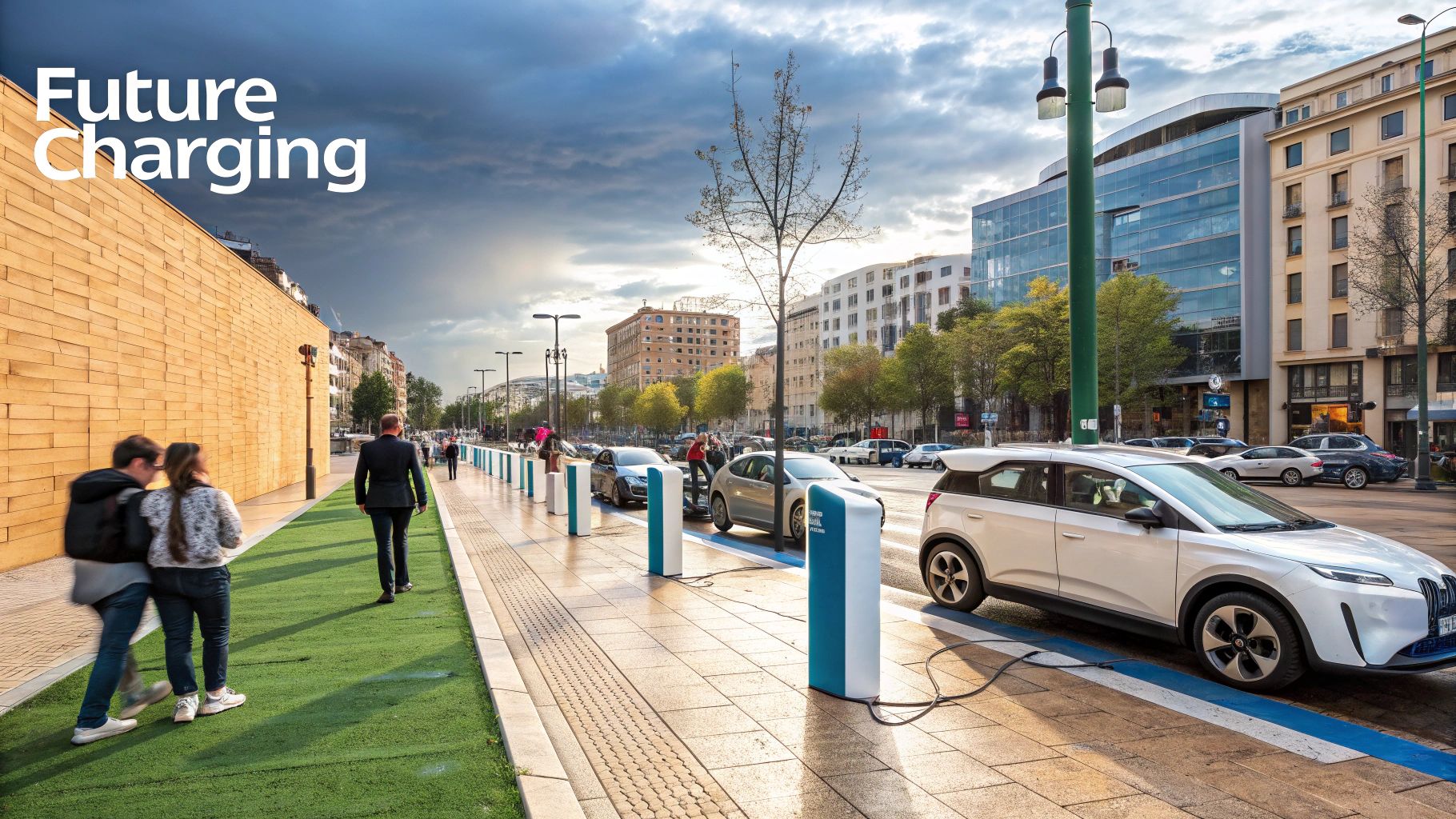
Mobile EV charging is much more than a simple lifeline for a stranded driver. For savvy entrepreneurs, it’s a massive and growing business opportunity, a chance to get in on the ground floor of the electric transition. This isn't just about calming electric vehicle range anxiety ; it's about building a profitable business based on convenience and on-demand service.
With the number of EVs on UK roads shooting up, the demand for flexible charging solutions is exploding right along with it. A mobile charging business is the direct answer. It's a chance to become a vital part of the future of transport, offering a crucial service that the fixed charging network simply can't match for sheer adaptability.
Unpacking the Business Model
The business model for a mobile charging operator is refreshingly simple, built on clear and direct revenue streams. Forget the colossal capital investment needed to install fixed charging points. The overheads for a mobile operation are a fraction of the cost, making it a far more accessible way to enter the booming EV market.
Operators make their money in two main ways. First, there's a charge per kilowatt-hour (kWh) of energy delivered, typically set at a premium to reflect the convenience of the on-demand service. Second, a fixed call-out fee is added to each job, just like any other roadside assistance service. This dual-income approach creates a reliable and predictable cash flow.
But the real magic of this model is its flexibility. You’re not tied to a single spot. You can move your assets to where the demand is, whether that’s a busy city centre during the week, a popular tourist spot on a weekend or a major event like a festival.
Calculating Your Earning Potential
The financial returns for a dedicated operator can be pretty substantial. By thinking strategically and positioning yourself in areas with a high density of EVs or along key travel routes, you can complete multiple charging sessions every single day. It doesn't take long for that to add up, turning a single van into a serious revenue-generating machine.
To give you an idea, let's look at some conservative numbers. An operator who completes just a handful of charges a day can bring in a significant weekly income. The combination of charging fees and call-out charges makes for a very strong business case.
A mobile charging business thrives by selling more than just electricity. It sells time, convenience and peace of mind—all high-value commodities for any EV driver staring at a low battery.
Beyond the day-to-day operations, you can also boost profitability through sustainable practices. Figuring out the ins and outs of reducing carbon footprint in your supply chain not only helps the planet but can make your business more efficient too.
Here’s a quick look at what the numbers could be for an operator, showing how quickly the earnings can stack up.
Potential Weekly Earnings for a Mobile Charger Operator
| Charges Per Day | Estimated Weekly Revenue (Charging Fees) | Estimated Weekly Revenue (Call-out Fees) | Total Potential Weekly Earnings |
|---|---|---|---|
| 2 | £280 | £420 | £700 |
| 4 | £560 | £840 | £1,400 |
| 6 | £840 | £1,260 | £2,100 |
| 8 | £1,120 | £1,680 | £2,800 |
Note: These figures are illustrative, based on an average charge of 20 kWh at £1.00/kWh and an average call-out fee of £30, operating 7 days a week. Actual earnings will vary based on your pricing, location and operational efficiency.
As you can see, even a moderate number of daily call-outs can translate into a very healthy weekly income, demonstrating the real financial viability of this business model.
Advantages Over Fixed Infrastructure
A mobile charging business has some serious advantages over traditional fixed charging stations, making it a nimble and highly competitive alternative.
- Low Initial Investment: Setting up a fixed charging hub costs a fortune in grid connections, groundwork and hardware. A mobile unit is a tiny fraction of that cost.
- Ultimate Flexibility: Mobile chargers can be deployed anywhere, anytime. This lets you serve forgotten neighbourhoods, respond to emergency calls or provide power at temporary events where fixed points are impossible.
- Direct Customer Engagement: As an operator, you're providing a personal, face-to-face service. This is gold for building customer loyalty and sparking positive word-of-mouth recommendations.
By jumping into this model, you’re not just starting a business. You’re providing a truly essential service that tackles one of the biggest hurdles to EV adoption head-on, turning electric vehicle range anxiety into a profitable business.
Driving into a Confident Electric Future
Our journey through the world of electric vehicle range anxiety has shown one thing clearly: this fear is a solvable psychological barrier, not a technical failing of modern cars. The old worries are fading, replaced by practical, real-world solutions that inspire confidence on every journey.
With today’s EVs offering more than enough range for the average UK driver's daily needs, the foundation for a stress-free experience is already in place. The days of limited mileage are long gone, as most vehicles can now handle a week or more of commuting on a single charge. This capability alone gets to the heart of what used to make drivers nervous.
The Complete Support System
Backing up these advanced vehicles is a dense and rapidly growing public charging network that now outnumbers petrol stations across the UK. This extensive infrastructure means a top-up is almost always nearby, turning the question from "if" you can charge to simply "where" you’ll do it. For most drivers, this network is more of a reassuring backup than a daily necessity.
The ultimate safety net, however, comes from innovative mobile charging services. Companies like ZAPME provide the final piece of the puzzle, delivering on-demand power directly to your vehicle, wherever you are. This service effectively eliminates the worst-case scenario, transforming a potential crisis into a minor inconvenience and providing total peace of mind.
We’ve reached a turning point. The combination of vehicle capability, fixed infrastructure and mobile support has made electric vehicle range anxiety a relic of the past. The focus can now shift from fear to freedom.
This new reality presents a dual opportunity. For drivers, it’s time to fully embrace the electric transition, confident that the technology and support systems are more than ready. The road ahead is clear, charged and free from the old anxieties that once held people back.
For entrepreneurs, this marks the chance to become a key part of the solution. The rise of mobile charging creates a powerful business model, allowing operators to provide a crucial service while building a profitable venture. Whether you're a driver seeking complete confidence or a businessperson ready to power the future, the path forward is bright.
Frequently Asked Questions About EV Range
Even with modern EVs and the incredible support network out there, a few specific questions always seem to pop up. Let's tackle them head-on with clear, straightforward answers to settle any final doubts you might have about making the switch.
Think of this as the practical stuff drivers actually worry about. The goal is to get you feeling fully prepared and confident for the road ahead.
How Much Does Cold Weather Affect an EV's Range?
There's no getting around it: cold weather does reduce an EV's range, sometimes by up to 20-30% . This happens for two main reasons. First, lithium-ion batteries just aren't as efficient when it's frosty outside. Second, a decent chunk of energy goes into heating the cabin to keep you comfortable.
But you can easily get a lot of that range back. A great habit is to pre-heat your car while it’s still plugged in and charging. Also, try using the heated seats and steering wheel—they're often far more energy-efficient than blasting the main heater to warm up the entire space.
Is it Bad to Always Charge an EV to 100%?
For your day-to-day driving, it's best practice to charge your EV’s battery to around 80% . This simple habit helps prolong the overall health and lifespan of the battery pack over many years of ownership.
Most modern EVs make this incredibly easy, letting you set a charging limit right from the car's screen or a smartphone app. Of course, charging to 100% is perfectly fine—and necessary—for those long journeys when you need every last mile to reach your destination without a worry.
What Happens if I Completely Run Out of Charge?
Running out of charge completely is a very rare event for most EV drivers. But if it does happen, you’re not left stranded. This is precisely where on-demand mobile charging services come in as the ultimate safety net, directly tackling the core of electric vehicle range anxiety .
Services like ZAPME operate a lot like a traditional breakdown service that would bring you a can of fuel. A specialised vehicle comes directly to your location and gives you a rapid top-up, providing more than enough power to get back on the road and reach a fixed charging point or your final destination.
Are Public Chargers in the UK Reliable?
The UK's public charging network is constantly growing and getting much more reliable. While you might still come across the odd faulty charger, the overall experience for drivers has improved massively.
These days, brilliant tools have made navigating the network simple. Apps like Zap-Map are essential, giving you real-time updates on whether a charger is in use or out of service, along with user reviews. This lets you plan your journey around reliable and available charging points, taking all the guesswork out of the process.
Ready to turn electric vehicle range anxiety into a business opportunity or just want to ensure you never worry about a flat battery again? ZAPME offers cutting-edge mobile charging solutions that deliver power wherever it's needed. Discover how you can join the mobile charging revolution by visiting https://www.zapme.biz.

